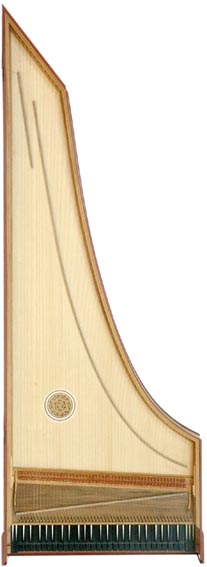|
The plan view |
||
|
This is the plan view of harpsichord number 4.
|
One of the striking features of the design of this and the other three harpsichords made at the same time is the large length of the instrument in relation to its width, the latter being determined basically by the instrument's compass. The reason for the length of these instruments is that the strings are designed to have Pythagorean scalings throughout the whole of the compass right down to the lowest note. This means that the string lengths double exactly with each octave drop in pitch. The right-hand bridge is designed so that the string lengths, based on a c2 scaling of 13 once = 283.9mm double in length right down to the note F. If brass strings are used at this scaling and at a pitch of a1 = 415.3Hz, then the strings are tensioned to within about 2 semitones of their breaking point - that is, if the strings were tuned up a further two semitones, they would break. The bass bridge at the left of the soundboard area is designed to have Pythagorean string lengths from C to E which are based on a c2-equivalent scaling of 10½ once = 229.3mm, so that bottom C has a length of 8´10½ once = 84 once = 1834mm. This is as long as or, in some cases, even longer than the bottom F1 note on most French harpsichords. However the bass notes of a French harpsichord are not tensioned anywhere near to their breaking point for this note. If red brass strings are used at this scalings and at a pitch of a1 = 415.3Hz, then the strings are also tensioned to within about 2 semitones of their breaking point. Physical theory shows that the tighter strings are tensioned the more accurately tuned are the overtones of the strings. At a high tension the frequencies of the overtones approximate to those of the notes of a true harmonic series. A sound with accurately tuned harmonics is immediately recognised by the ear as a sound with clear musical properties. For this reason the strings in most Western Art instruments are always tuned as close to their breaking point as is possible. Although the top notes of a French harpsichord have Pythagorean scalings with a musical overtone structure, the bass notes of a French harpsichord are considerably below their breaking point, and have a correspondingly un-musical property. Only by lengthening the strings could this situation be improved. A string tuned with a tension which gives a safety factor of 2 semitones below its breaking point is as highly stressed as it can be without undue risk of breaking . Tensioning all of the strings to this point ensures that the sound is equally musical throughout the whole of the compass and produces a clear, balanced sound. The compromise of using slightly slack strings in the bass was not considered because of the resulting deleterious effect on the sound quality there.
Go back to the main page of this section
|
|
